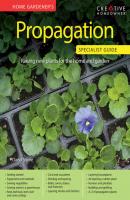Home Gardener's Propagation (UK Only). David Squire
Чтение книги онлайн.

Читать онлайн книгу Home Gardener's Propagation (UK Only) - David Squire страница 4
Название: Home Gardener's Propagation (UK Only)
Автор: David Squire
Издательство: Ingram
Жанр: Сад и Огород
isbn: 9781607652427
isbn:
Plants grown indoors, in greenhouses and in conservatories, range from those raised from seed to those produced from cuttings or by division.
Begonia
Equipment and materials
What equipment do I need?
Depending on the plants you are raising, everything from seed-trays (flats), pots and dibbers (dibbles) to greenhouses and garden frames comes in handy. Increasing woody plants by hardwood cuttings needs only a sheltered piece of land, sharp sand and a spade, and layering a shrub requires just a few pieces of equipment. Sowing half-hardy annuals in late winter and spring needs a greenhouse, a method of heating, seed-trays (flats), compost and a sieve.
TOOLS AND MATERIALS
Once bought – and if regularly cleaned and maintained – many pieces of gardening equipment last for ten or more years. The ‘consumable’ elements, such as compost, seed-trays (flats) and pots, will, of course, need to be bought more often – perhaps yearly, and usually in late winter or early spring. Compost will also be needed in summer when transferring seedlings and cuttings into pots.
When not in use, place equipment such as propagators and heaters in a dry, well-ventilated shed. Ensure they are clean and dry, then seal them in polythene bags. Check yearly that cables and plugs on electrical equipment have not perished or cracked. Where compost is saved from one year to another, seal the bag’s top to prevent it becoming dry and contaminated with pests.
Composts
Several types of compost are available, including loam-based and peat-based varieties.
• Most home gardeners use bags of ready-prepared seed compost when sowing seeds in pots and seed-trays (flats), rather than buying separate ingredients and mixing their own. Never just use garden soil.
• For rooting cuttings, a mixture of equal parts moist peat and sharp sand is best.
Compost
Seed-trays (flats) and pots
Plastic seed-trays (flats) are essential when you sow half-hardy annual seeds in greenhouses. You will also need pots in a range of sizes – ones 7.5–8 cm (3–3½ in) in diameter are most often used, and both plastic and clay types are available. When seeds are sown in pots, shallow ones, such as Jiffy pots, are useful.
Seed-tray (flat)
Seed-tray with ‘cells’
Peat pot
Jiffy pots
Sieves
You will need a flat-based horticultural sieve, 15–20 cm (6–8 in) wide and 7.5–10 cm (3–4 in) deep, to evenly cover seeds with compost. Alternatively, use a culinary sieve.
Sieve
Dibber (dibble)
Small plastic dibbers (dibbles), 10–15 cm (4–6 in) long, are useful for transferring seedlings from where they germinated into wider spacings in seed-trays (flats) or into individual pots. Plastic types are easier to keep clean than wooden ones.
Dibber (dibble)
Greenhouses
Heated greenhouses are essential for raising half-hardy annuals (summer-flowering bedding plants) in spring. Several forms are available, including ‘even-span’, ‘lean-to’ and ‘miniature lean-to’, as well as partly glazed sheds. With all of them, good ventilation is essential, as well as adding warmth in late winter and spring. Remember that the larger the greenhouse is, the easier it will be to achieve a uniform and even temperature (but it will also be more expensive to heat).
Even-span: orientate the ridge east to west
Lean-to: position against a warm, sheltered wall
Mini-type: secure to a wall that is sheltered from wind
Glazed shed: orientate the glass towards the sun
Insulating greenhouses
To reduce heating costs in late winter and spring, when sowing seeds, attach plastic bubble-wrap glazing to the inside of metal or wood greenhouses. Leave space for the ventilator to open and close, and use drawing pins to hold the bubble glazing in place in wooden greenhouses, or special plastic fittings for use in aluminium greenhouses.
Heating a greenhouse
Paraffin (kerosene) heaters: These create warmth and give off moisture that will need to escape through ventilators. They are efficient, but if badly maintained and with a wick that is set too high will produce smoke.
Electric fan heaters: Most have built-in thermostats to ensure that the desired temperature is maintained. Waterproof cables and sockets are essential; avoid hot draughts on plants.
Tubular electric heaters: These are controlled by a thermostat. Ensure that the hot air can rise freely.